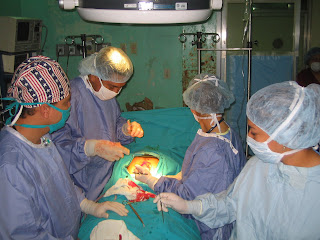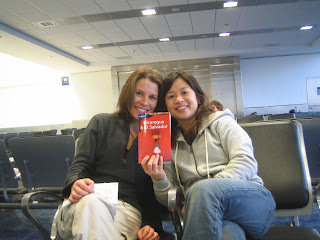Welcome back to the States, Jimmy D! Thanks for your e-mail to Amy and me. Before I forget, I wanted to comment as well about c-sections here. Fortunately, there are Russians, Kochers, and all the usual surgical tools -- including the beloved bladder blade. Because they do vertical skin incisions, some make bladder flaps and some don't. The uterus is always closed with two sets of running locked stitches. The peritoneum always closed (locked) and the fascia is also closed with locked stitches. If it's a vertical incision, it's vertical mattresses for the skin; if it's a pfannensteil, it's a running subcuticular. The residents are pretty fast with their sections and babies are out in about two minutes (literally), but closing is another story because they also keep the uterus inside on top of using sutures for everything... I told them I'd dig up some much-needed grapas (staples) for them when I got back to the States!
Alright, enough medical stuff -- on to a recap of our weekend, which Amy and I decided felt like our very own "Amazing Race" in that we had clear objectives in mind but not the organization, punctuality, or paved roads we're used to in the States. But the chaos is what helps make the memories...
***
THE AMAZING RACE - NICARAGUA, Episode 1:
Our mission goals:
1. Have laundry done by the weekend
2. Meet up with Maritza's family in Matagalpa on Saturday afternoon/night
3. Try a guirilla and visit the famed church in town
4. Purchase 4 lbs of coffee each at Selva Negra, a German-owned coffee farm
5. Catch the 3 pm express bus back to Leon on Sunday
**Amy continues the blog....***
1). So getting the laundry done here is pretty simple. We drop it off at "Big Foot," an Aussie-run hostel where you can pay $3.50 for a weeks' worth of clothing for two petite chicas. Wash, dry and fold! A bargain. They also sell these awesome brownies. Also of note- the residents are OBSESSED with our matching scrubs. I promised one of the anesthesia residents that she could have mine, and I think I may have made her year. She reminds me of it everyday. Task is completed!
2.) El terminado. Imagine a chaotic center with no ticket booth, no list of schedules, vendors and their children running every which way selling everything from religion to red soda pop. Nicaraguan buses are large yellow school buses with colorful decorations on the side- Bob Marley, Jesus- the important things...... Miraculously, Cindy and I somehow to found the correct bus. However, it was overflowing with people on the way to Matagalpa. Wisely, we decided to wait for the next one as the trip is approximately four hours and without AC or an intact shock system. After a seemingly endless journey over marginally constructed roads we arrived in Matagalpa, the "Bay area of Nicaragua," a pleasantly cool and mountainous region. We were welcomed by Maritza's loving family who spoiled Cindy and me with adorable babies and puppies, delectable food and plenty of smiles and hugs.
***Cindy continues the blog...*** (this blog has been written over the course of three days)
3.) Maritza's sister, Lorena, took us on a stroll of Matagalpa center including to its main church in town. Afterward we waited in a looooong line for freshly-made corn tortillas called guirilas, a Matagalpan specialty. They were slightly thicker and sweeter than regular tortillas and quite delicious.
4.) On Sunday morning we took off to Selva Negra (
www.selvanegra.com), a large self-sustaining coffee farm 12 kilometers away. It was started and continues to be run by the same German family. Aside from cultivating organic coffee, they also raise cattle, chickens, and pigs, along with growing flowers and vegetables. We found out on our microbus tour of the farm that they have something like 300 workers, who also live there. They're provided with housing, schooling for the kids, baseball teams, a medical clinic, and three meals a day. Additionally, once the kids graduate from elementary school, they can receive scholarships to a private secondary school in town, and eventually even to a university if they wish to continue. It's an interesting concept to have such a self-sustaining farm and community. Their website has more information for those who are curious. Oh yes, and their coffee truly is delicious. We both purchased 4lbs worth!
5.) After taking the crowded non-express bus from Leon to Matagalpa on Saturday with many, many local stops, we decided to try to catch the 3 pm express bus back. It was a challenge buying tickets as we were first told we could purchase them in advance, so we went to the bus terminal on early Sunday morning. When we got there, they said we couldn't purchase them until after 1 pm. We returned to the bus terminal around 2 pm only to be told that the bus was somewhere behind the terminal. We walked around and found one lone bus and hopped on, only to be told that there were assigned seats. So we hopped off, unsure of how to purchase these elusive tickets, only to be told that the guy selling the tickets was ON the bus. So we went back on the bus and finally bought our two tickets and sat down in seats #41 and #42. It was nice to be on a direct bus with no stops, allowing us to secretly sing along with and enjoy the 80s music without interruptions. We're talking classics from our childhood like: "Eternal Flame", "The Eye of the Tiger", and "The Search is Over" just to name a few!
We arrived back in Leon at 6 pm, collected our washed laundry, and was then pleasantly surprised to be met by Jorge (our very sweet and funny night-time security guard who we call our "bodyguard") and his shy 5-year old son, Franklin, of whom we had only seen pictures.
Overall, a fun filled 36-hours -- mission accomplished. ;) We took lots of pictures and will try to upload them later tonight if energy suffices. For now, we're off to our last day in the hospital. Tomorrow (Wed and Thurs) we will be trekking out to Poneloya, a beach town, to work at a rural clinic!
Amy and Cindy












































